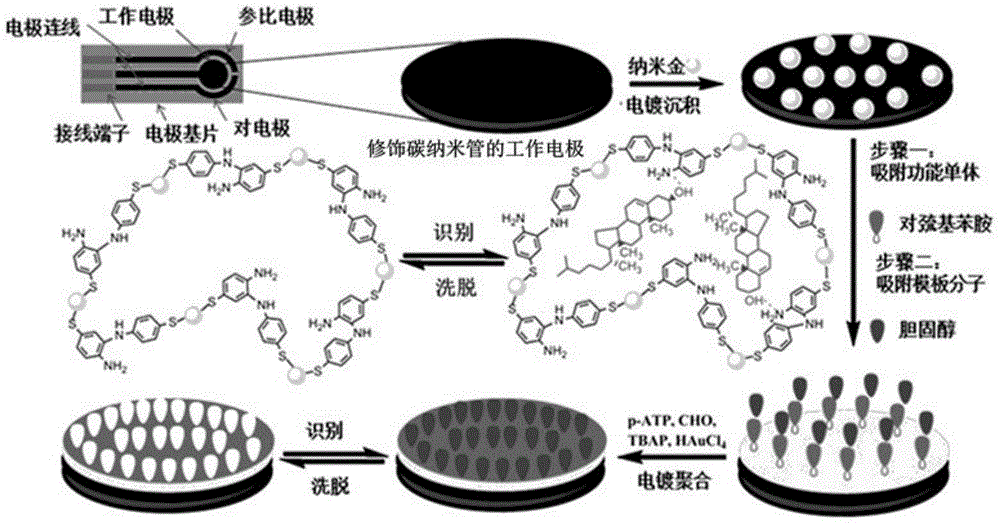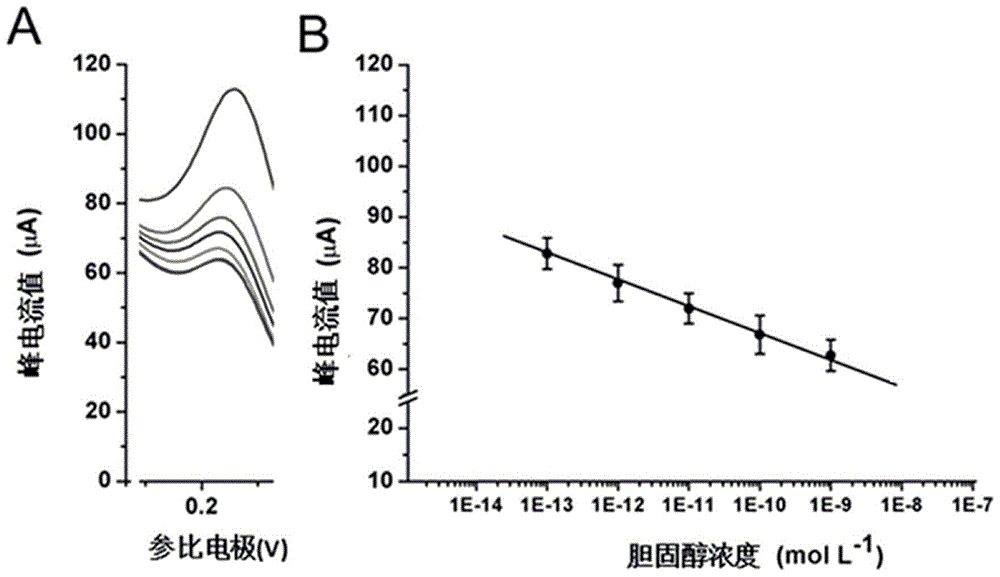A Portable Cholesterol Molecularly Imprinted Screen Printing Electrochemical Detector
A technology of screen printing electrodes and molecular imprinting, applied in electrochemical variables of materials, scientific instruments, instruments, etc., can solve the problems of poor cholesterol recognition ability, easy inactivation of enzymes, false positives, etc., to avoid instability and stability. The effect of short time and convenient detection
- Summary
- Abstract
- Description
- Claims
- Application Information
AI Technical Summary
Problems solved by technology
Method used
Image
Examples
Embodiment 1
[0050] Example 1 Preparation of Cholesterol Molecularly Imprinted Screen-Printed Electrode
[0051] Schematic diagram of the preparation of cholesterol molecularly imprinted screen-printed electrode sheet as shown in figure 1 shown. The specific preparation method is as follows:
[0052] (1) Decorate carbon nanotubes on the surface of the working screen-printed electrode: mix 500 mg of multi-walled carbon nanotubes with 60 mL of concentrated nitric acid, boil at 85 degrees for 12 hours, then pass through a 0.22 μm polycarbonate membrane after cooling, wash with water, and blow dry with nitrogen Finally, 5 mg of the prepared carboxylated multi-walled carbon nanotubes were mixed with 10 mL of 1.0 wt % chitosan (acetic acid as a solvent), and then 10 μL was drawn and dropped onto the working electrode, and dried at room temperature.
[0053] (2) Electroplating and depositing gold nanoparticles on the surface of the working screen printing electrode, electroplating method: the w...
Embodiment 2
[0062] Example 2 Application of Cholesterol Molecularly Imprinted Screen Printing Electrode
[0063] The sample test steps are as follows:
[0064] First, a standard (known concentration of cholesterol) molecularly imprinted screen-printed electrode is inserted into the portable detector to calibrate the detection results of the portable detector. Then mix the purified cholesterol sample with an equal volume of conductive solution, the configuration of conductive solution: 2.5mmol L -1 [Fe(CN)6] 3- / 4- and 0.1mol L -1 KCl solution, drop 20 μL of the mixture of cholesterol sample and conductive solution on the surface of the screen-printed electrode of the prepared cholesterol molecularly imprinted membrane, let the static adsorption time: 120s, set the voltage range: 0.1V ~ 0.3V, record the scanning The current peak value is calculated according to the standard curve between the cholesterol concentration and the current peak value built in the cholesterol-specific portable d...
Embodiment 3
[0068] Example 3 Application of Cholesterol Molecularly Imprinted Screen Printing Electrode
[0069] In a portable detector of the present invention, which is a dedicated portable detector for cholesterol, the standard curve between cholesterol concentration and peak current has been built into the detector program.
[0070] The drawing method of this standard curve: prepare different known concentrations (concentration range: 1 * 10 -13 ~1×10 -9 mol L -1 ) cholesterol molecule imprinted screen-printed electrode is inserted into the detector to detect the current peak value formed when electrons flow from the counter electrode, through the conductive liquid, and then from the working electrode back to the workstation. Take the cholesterol concentration as the abscissa, and the peak current value as the ordinate Coordinates, the standard curve is obtained, such as image 3 shown. The standard curve equation that obtains is: I p =-5.033LogC+16.885(R 2 =0.995), the detectio...
PUM
| Property | Measurement | Unit |
|---|---|---|
| volume | aaaaa | aaaaa |
Abstract
Description
Claims
Application Information
 Login to View More
Login to View More - R&D
- Intellectual Property
- Life Sciences
- Materials
- Tech Scout
- Unparalleled Data Quality
- Higher Quality Content
- 60% Fewer Hallucinations
Browse by: Latest US Patents, China's latest patents, Technical Efficacy Thesaurus, Application Domain, Technology Topic, Popular Technical Reports.
© 2025 PatSnap. All rights reserved.Legal|Privacy policy|Modern Slavery Act Transparency Statement|Sitemap|About US| Contact US: help@patsnap.com



